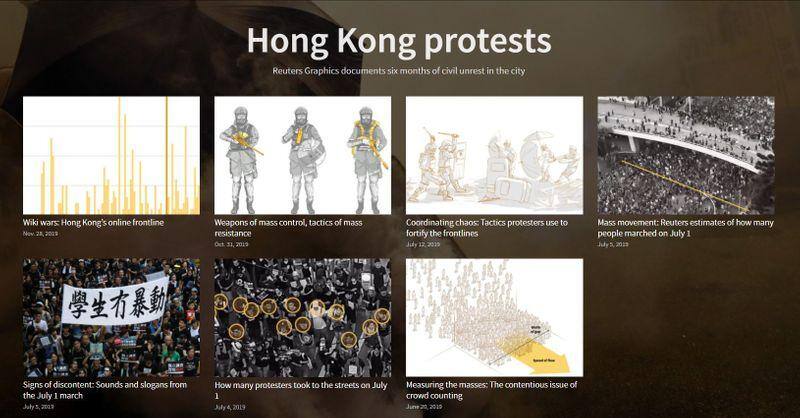Reuters last week received four journalism award recognitions for its interactive graphics, from the Online News Association (ONA) and the World Association of Newspapers and News Publishers (WAN-IFRA).
Reuters won an Online Journalism Award-presented by ONA and which celebrates the best in digital journalism around the world-for Excellence and Innovation in Visual Storytelling for a series graphics on the Hong Kong protests. The series was also named a finalist in the Explanatory Reporting category.
Reuters also had one winner and one finalist in the Asian Digital Media Awards, presented by WAN-IFRA. Drowning in Plastic won the top prize for Best Data Visualization, while a series of explanatory infographics on COVID-19 was named a finalist for Best Special Project for COVID-19.
Asia Graphics Editor Simon Scarr explains what went into creating the award-winning graphics on the protests and how instrumental graphics can be when it comes to delivering the full picture of a story"
"When large-scale demonstrations plunged Hong Kong into political crisis in June 2019, the size of the crowds became a contentious issue. Police gave relatively low numbers and protest organisers offered sharply higher estimates. The competing claims were being watched as a proxy for the degree of public support for the protesters and their demands.
The Reuters Graphics team deployed to Hong Kong in order to cover the July 1 rally, one of the summer's defining mass protests. From this one short trip, the team gathered enough information to produce a series of powerful visual stories.
The primary aim was to conduct an independent crowd-counting analysis for the march. The team deployed to elevated positions along the route and spent hours collecting data. The complicated and time-consuming process paid off with a powerful independent analysis, "How many protesters marched on July 1?"
While monitoring the rally, footage from Reuters cameras also helped the team document human chains passing equipment to those fighting against police and the evolving hand signals protesters used to communicate amidst the chaos. The result was another in-depth explanation titled "Coordinating chaos."
A separate camera filmed the entire march from start to finish, allowing the team to combine the crowd count data with an annotated time lapse of the rally. "Mass movement" was an immersive experience that brought the reader as close to the rally as possible without setting foot in Hong Kong.
A few months later, the protests became increasingly violent. Reuters set out to quantify and depict the escalating force of the police response and explain the events unfolding. A huge data collection exercise formed the backbone of a special report titled "Weapons of mass control, tactics of mass resistance".
As protesters and police continued to clash on the front lines, Reuters discovered another battle was quietly raging. Some innovative data reporting revealed that edit wars were playing out over the city's depiction online on the crowd-sourced internet encyclopaedia, Wikipedia. The piece, "Wiki wars: Hong Kong's online frontline," visually presented those findings.
The projects drew on innovative reporting techniques, data, visuals, and strong presentation to connect the dots for readers and to illustrate the evolving nature of the protest movement."
For the latest from Reuters Graphics, click here.
[Reuters PR Blog Post]
Media contact:
Tumshie Smillie
tumshie.smillie @ tr.com



